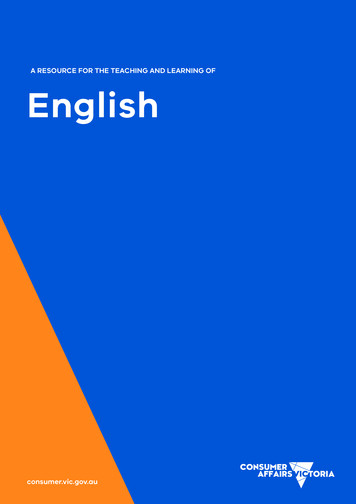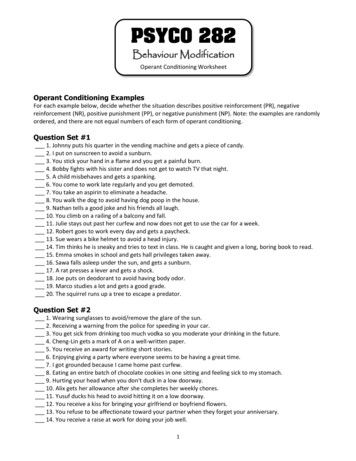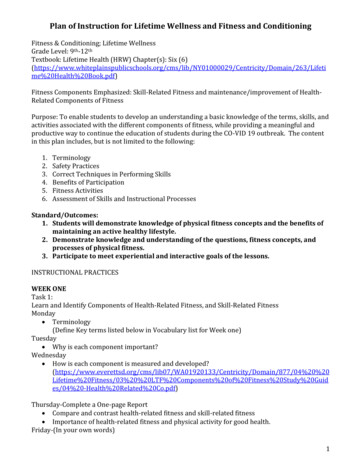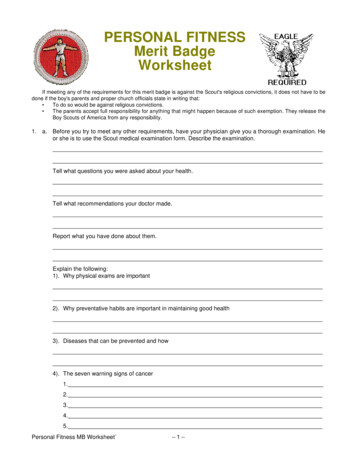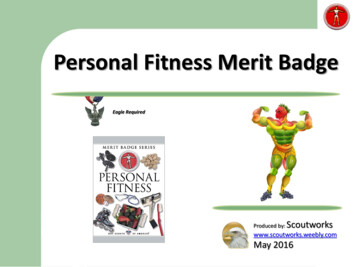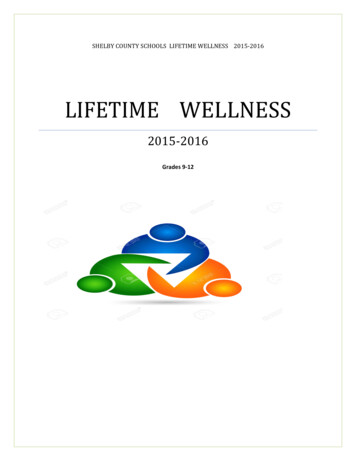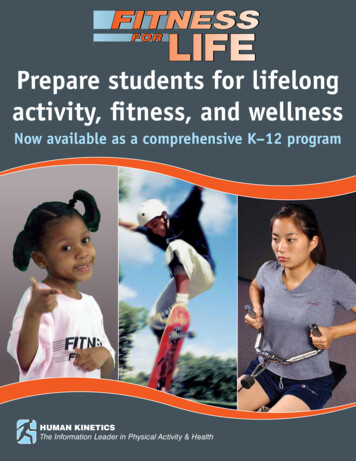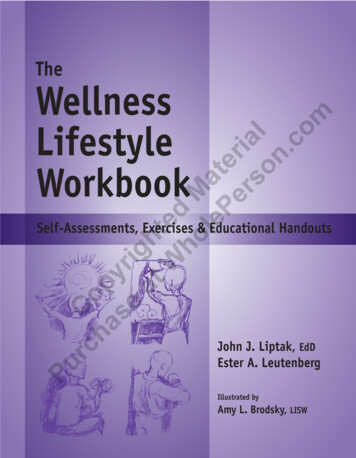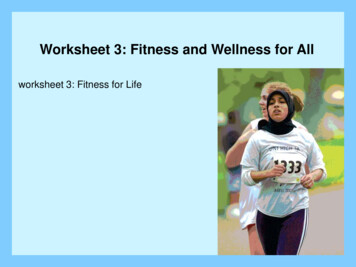
Transcription
Worksheet 3: Fitness and Wellness for Allworksheet 3: Fitness for Life
worksheet 3: Fitness for LifeQuestionWhat is meant by the term physical fitness?
worksheet 3: Fitness for LifeAnswerPhysical fitness is the ability of the body systemsto work together efficiently to enhance healthand improve performance in our daily lives.
worksheet 3: Fitness for LifeSome of the systems that worktogether are muscles, heart and cardiovascularsystem, respiratory system, skeletal system, and nervous system.
worksheet 3: Fitness for LifeQuestionWhy is it important for people to be physically fit?
worksheet 3: Fitness for LifeAnswerPhysical fitness can lower the risk of diseases, improve the quality of life, lower the risk of injury, improve sport performance, improve work efficiency, and help you have energy to enjoy leisure.
worksheet 3: Fitness for LifeQuestionWhat does the term wellness mean?
worksheet 3: Fitness for Life Define Wellness: Wellness is a state of beingthat enables you to reach your fullest potential. It includes the following areas of our lives:Intellectual (being well informed), Social (beinginvolved), Emotional (being happy) , Physical(being physically fit) and Spiritual (beingfulfilled) Wellness is the positive component of goodhealth.
worksheet 3: Fitness for LifeQuestionWhat is meant by the term physical activity?
worksheet 3: Fitness for Life Physical Activity is movement of the largemuscles of the body. P.A. includes sports, dance, and activities doneat home or work such as walking, climbingstairs, or mowing the lawn. Most people becomeless physically active as they grow older. The Surgeon General’s report on PhysicalActivity and Health indicates that Physicalinactivity is a major risk factor for manyHypokinetic diseases.
worksheet 3: Fitness for Life Define Exercise
worksheet 3: Fitness for Life Exercise is physical activity done for the purposeof getting fit and is a scheduled period of time.
worksheet 3: Fitness for Life Good Health and Wellness helps us to be morephysically active. This cycle is called the Cycle of Physical Activity. The top box is PHYSICAL ACTIVITY .which leads to PHYSICAL FITNESS . which leads to WELLNESS . whichleads back to Physical Activity.
worksheet 3: Fitness for LifeQuestionWhat are the health benefits from being physicallyactive and physically fit?
worksheet 3: Fitness for LifePeople who are physically fit have LOWER RISK of HYPOKINETIC DISEASES .(cardiovascular diseases, Type II diabetes, osteoporosis,obesity). LOWER RISK of BACK PROBLEMS. Fit people can also: COPE WELL WITH STRESS or emergency situations. less likelihood of smoking cigarettes. participate in sports and outdoor recreationalactivities. function better as they grow older Lead physically active and happy lives
worksheet 3: Fitness for LifeQuestionHow can a person increase the amount of physicalactivity he/she may get in a day?
worksheet 3: Fitness for LifeAnswerA person increases the amount of physical activityhe/she may get in a day by scheduled exercise / workout sessions, Walk or ride a bike to work do daily lifestyle activity (yard work, gardening).
Worksheet 3:Physical ActivityQuestionWhat are the stages of physical activity?
Worksheet 3:Physical ActivityAnswerThe Stages of Physical Activity are: Couch potatoe – doing little or no activity Inactive thinker – thinking about beginning activity Planner – planning to be active Activator – beginning an activity program Active exerciser – the ultimate goal: doing regularactivity
Worksheet 4:Physical ActivityQuestionHow active are teenagers?
Worksheet 3:Physical ActivityAnswer Many teens are not active exercisers. Girls are less active than boys in all types ofactivity other than flexibility exercises. Activity levels decrease as teensget older.
Worksheet 3: Fitness Through Physical ActivityQuestionWhat is the Stairway to Lifetime Fitness?
Worksheet 3: Fitness Through Physical Activitya step by step process of becoming physically fit.
Worksheet 3: Fitness Through Physical ActivityQuestionHow is moving up the stairway helpful to becomingactive and fit?
Worksheet 3: Fitness Through Physical ActivityAs you climb the stairway you become more independent(less dependent)in your own fitness program by: Become physically active (DO) Become more fit Learn to self-assess your own fitness Learn to plan your own program and self-managementskills Learn to solve problems and make good decisions Become fit and active for the rest of your life
End lecture worksheet 3
blank
worksheet 3: Fitness for LifeQuestionWhat lifestyles lead to good health and wellness?
worksheet 3: Fitness for LifeIf you are healthy you are free from illnesses, you have good wellness, you have good physical fitness, and you have other indications of healththat a doctor can measure, suchas healthy blood pressureand cholesterol levels. Early definitions concentrated onillness; now they include wellness.
worksheet 3: Fitness for LifeAnswerLifestyles that lead to good health include being physically active on a regular basis, eating well, coping with stress, using good personal health practices,and avoiding destructive habits.
worksheet 3: Fitness for LifeQuestionWhat types of jobs and careers do not requiremuch physical activity?
worksheet 3: Fitness for LifeAnswerCareers in outdoor recreation, trades such as building, roofing, or gardening, military, police work, fire department, and professional sports.
worksheet 3: Fitness for LifeQuestionWhat types of jobs and careers feature a highphysical activity component?
worksheet 3: Fitness for LifeAnswerCareers in office work, computer jobs, hair styling, dentistry, library science, some types of teaching, and other white-collar jobs.
worksheet 3: Fitness for LifeQuestionHow can we tell who the most physically activepeople in this class might be?
worksheet 3: Fitness for LifeAnswerThe most physically active people in this class probably do many in-school activities:– physical education– sports teams– intramurals do many out-of-school activities:– community sports– active work– lifestyle or recreational activity
worksheet 3: Fitness for LifeQuestionWhat are other benefits of being physically activeand physically fit?
worksheet 3: Fitness for LifeAnswerFit people can cope well with stressful or emergency situations, participate in sports and outdoor recreationalactivities, function better as they grow older, and lead physically active and happy lives.
Self-Assessment 1: Exercise BasicsThere are two objectives: to learn how to do warm-up and cool-downexercises, and to learn how to count heart rate.Consult your workbook and follow the guidelinesfor self-assessment in this chapter.
Self-Assessment 1: Exercise BasicsQuestionDescribe the five warm-up exercises. What is thepurpose of each?
Self-Assessment 1: Exercise BasicsAnswerSome warm-up exercises are heart warm-up (jogging, walking), side stretch (abdominal, side muscles), knee-to-chest stretch (low back, buttocks), back and hip stretch (back and hip), and two-leg calf stretch (calf).(See text for photos, pages 7-9.)
Self-Assessment 1: Exercise BasicsQuestionDescribe the two methods of counting heart rate(pulse). What are some good rules to follow forcounting resting heart rate?
Self-Assessment 1: Exercise BasicsAnswerThe two methods of counting heart rate (pulse)are:1. carotid(neck pulse)2. radial(wrist pulse)
Self-Assessment 1: Exercise BasicsAnswerSome good rules to follow for counting resting heartrate are count early in morning, and determine one-minute resting rate, using 15 sec x 4, 10 sec x 6, 6 sec x 10.
Self-Assessment 1: Exercise BasicsQuestionWhat are some good rules to follow for countingexercise heart rate?
Self-Assessment 1: Exercise BasicsAnswerSome good rules to follow for counting exerciseheart rate are locate pulse quickly, do typical exercise before count, and choose a short count (e.g., 15 sec x 4) becauselong counts allow heart rate to slow down.
Define Wellness: Wellness is a state of being that enables you to reach your fullest potential. It includes the following areas of our lives: Intellectual (being well informed), Social (being involved), Emotional (being happy) , Physical (being physically fit) and Spiritual (being fulfilled)

